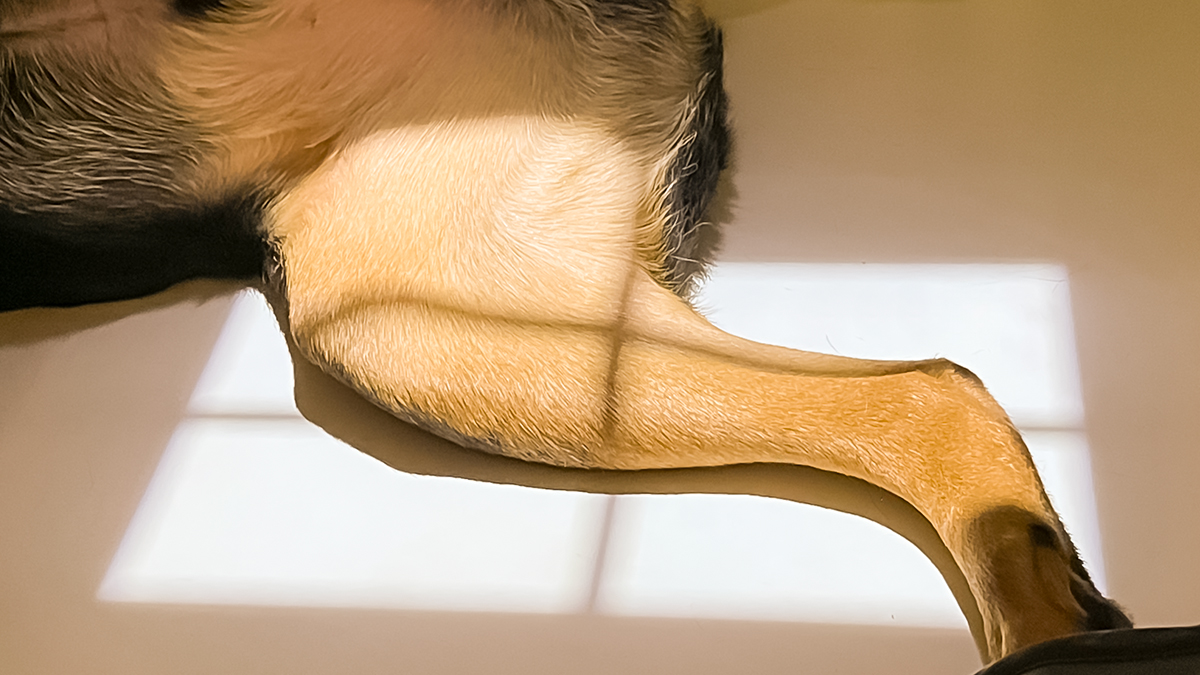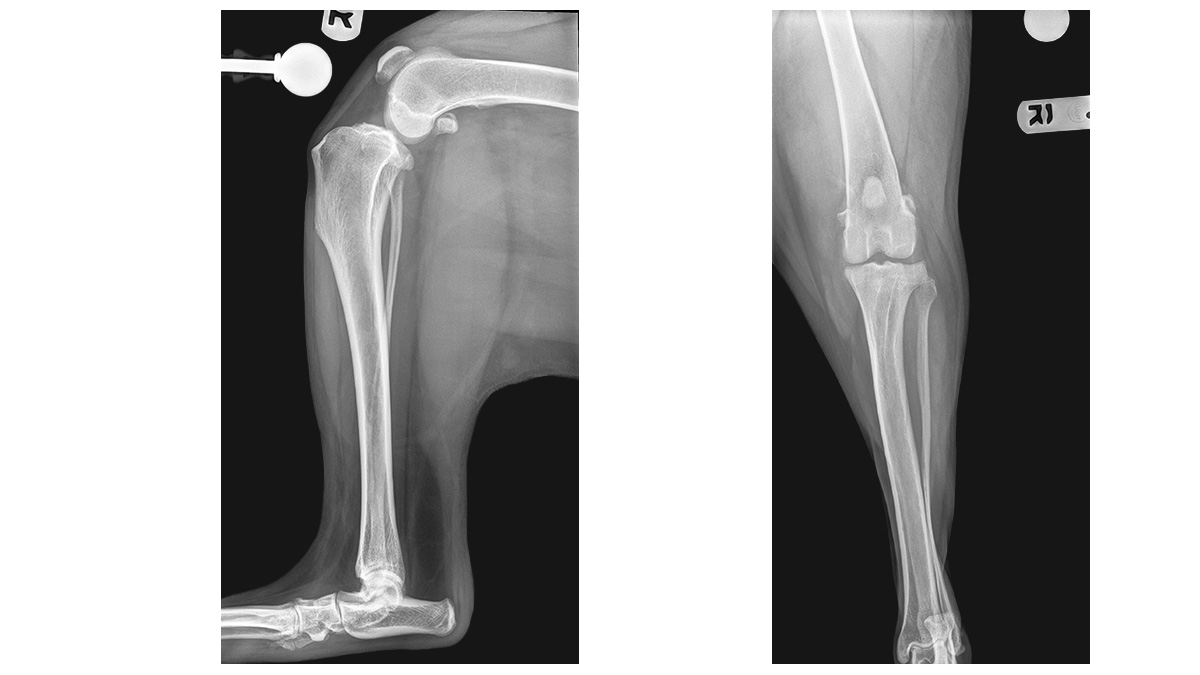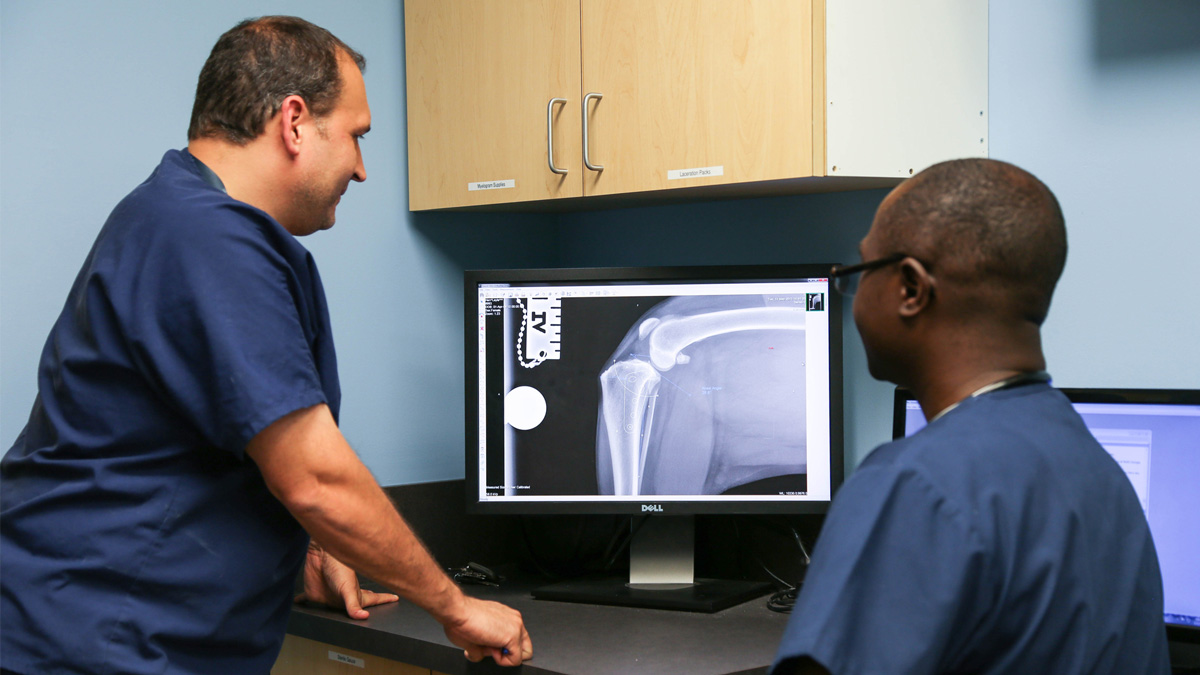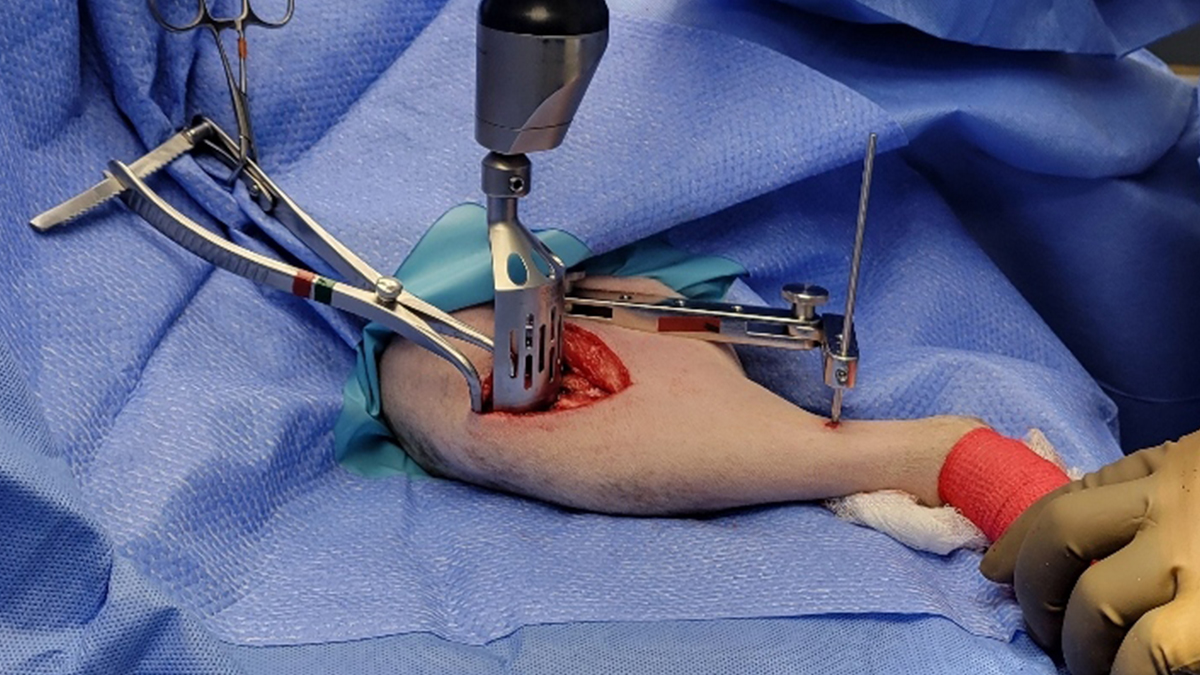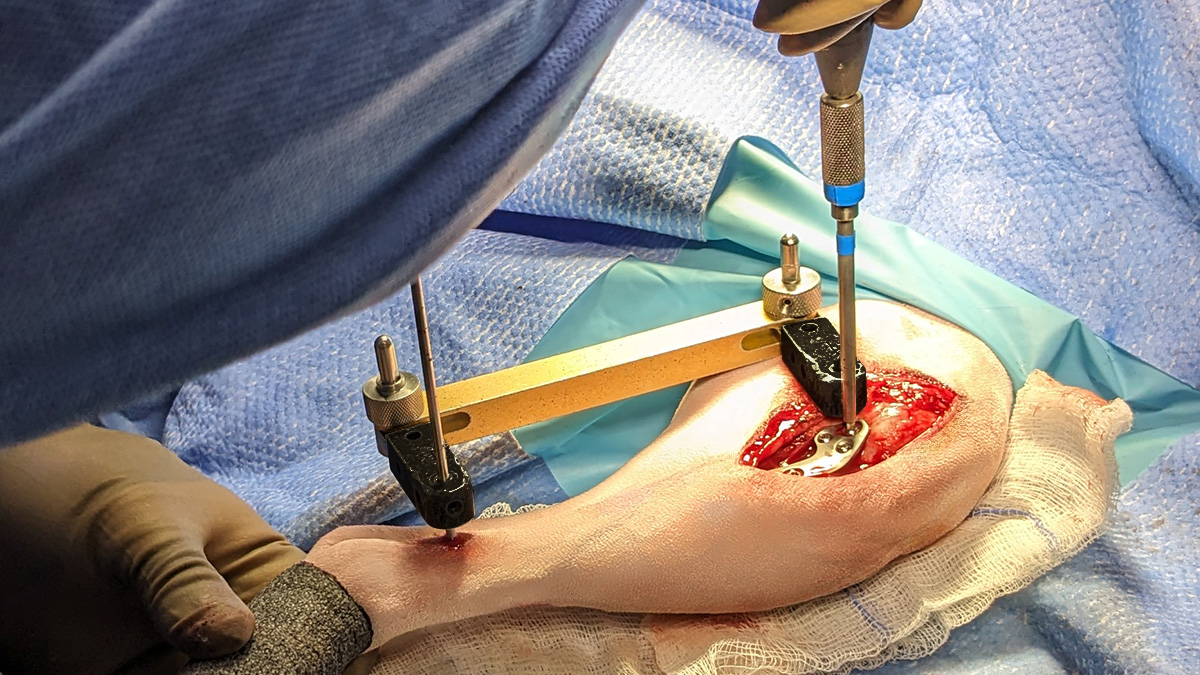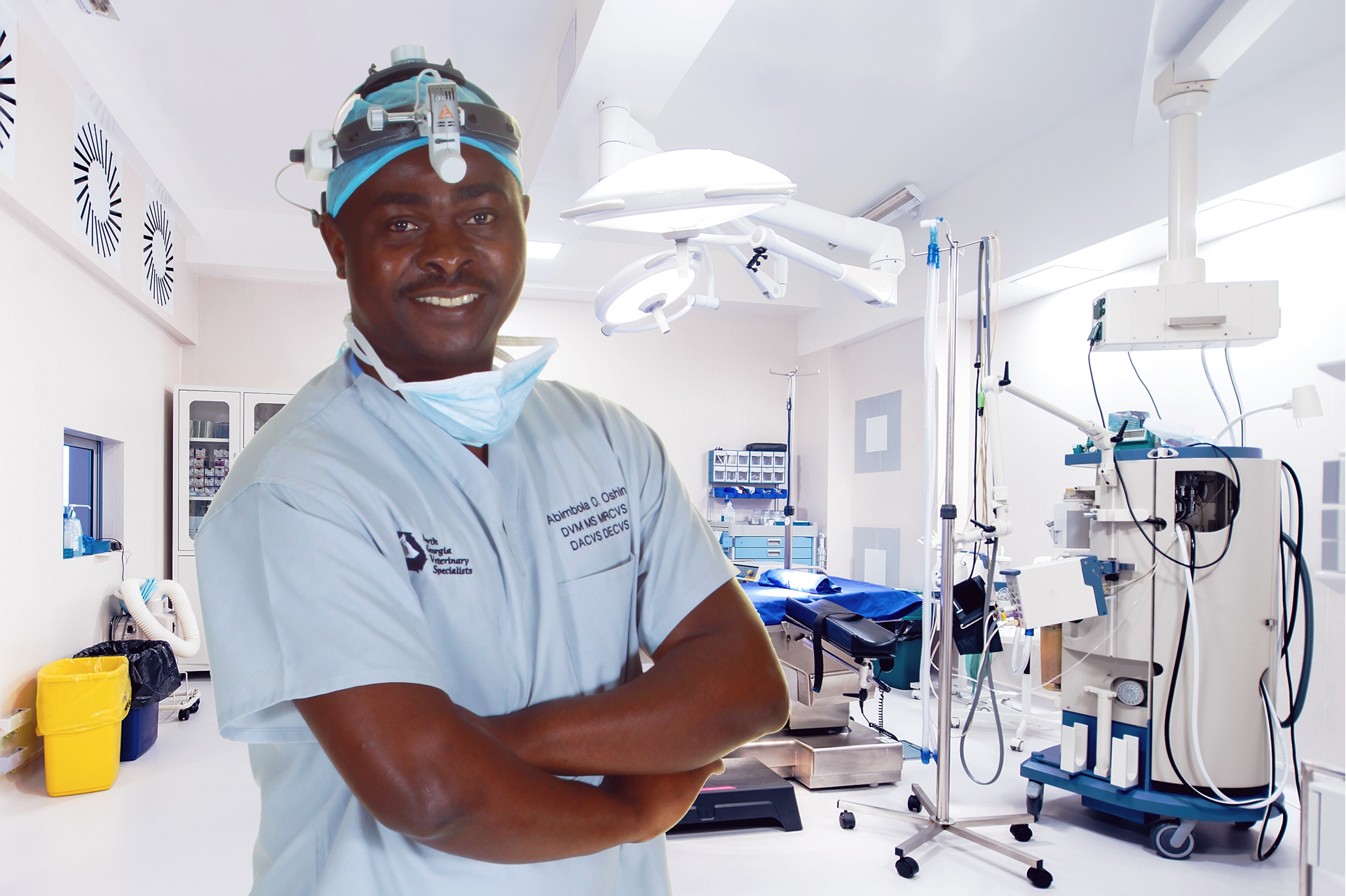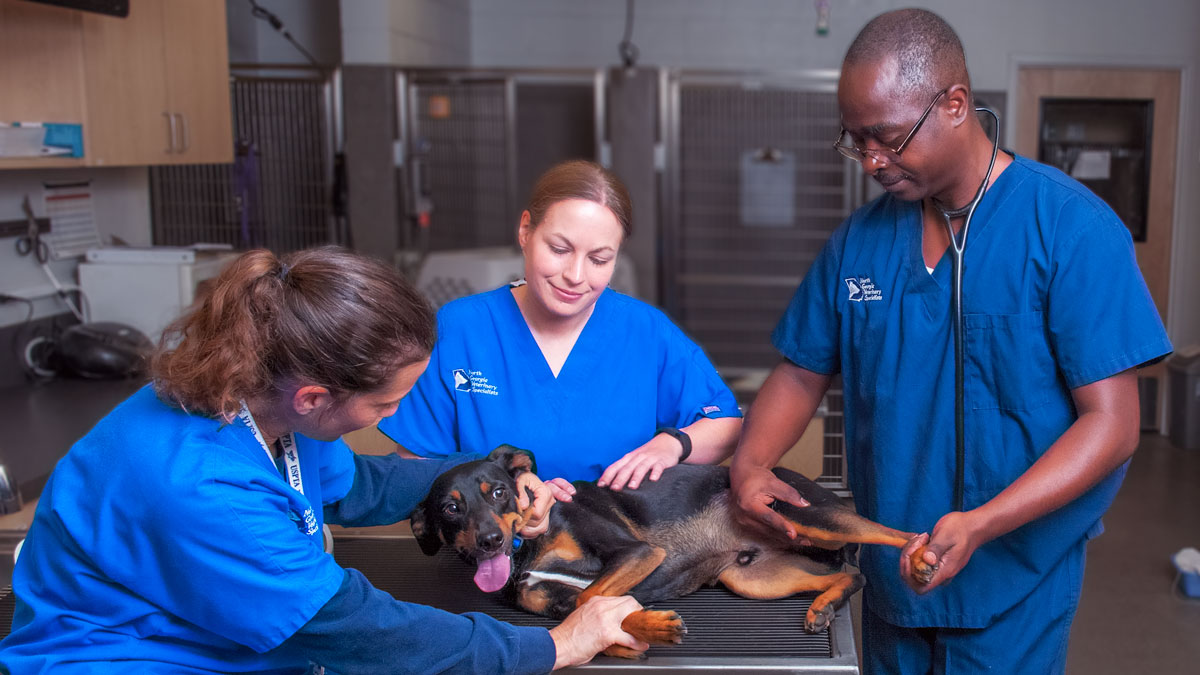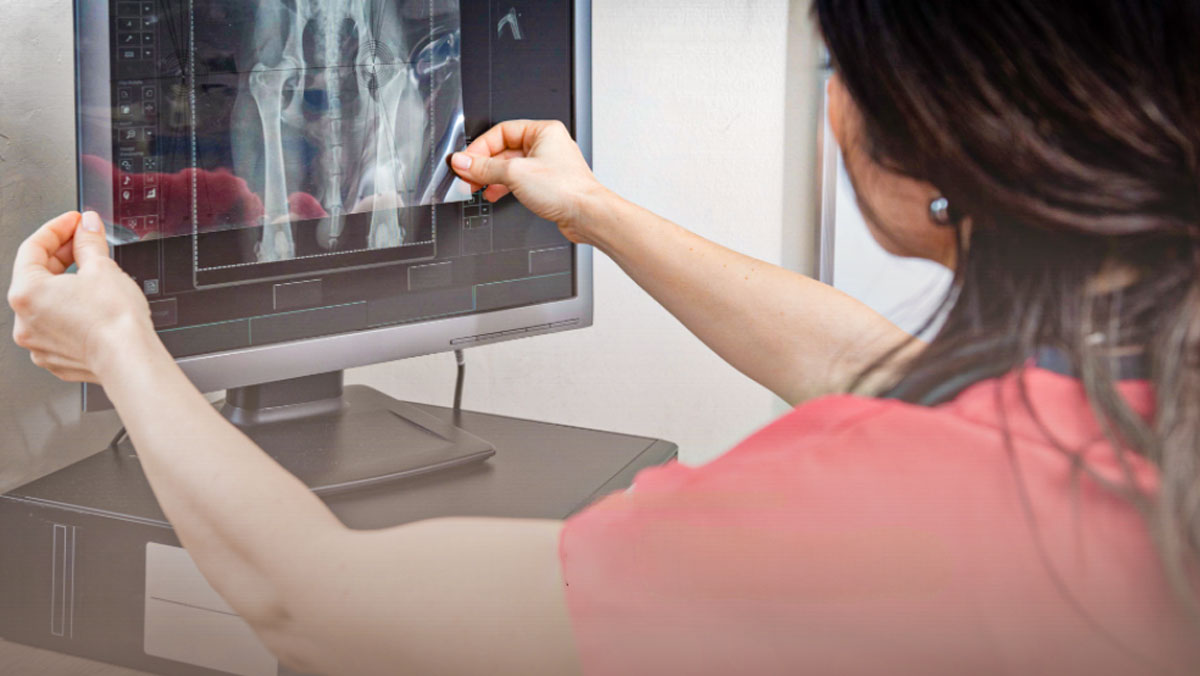Are you facing a cranial cruciate ligament (CCL) injury or rupture in your dog? Tibial plateau leveling osteotomy (TPLO) is an orthopedic surgery procedure that can restore knee (stifle) joint stability and normal function and eliminate the pain associated with a cranial cruciate ligament injury. CCL injury is one of dogs’ most common causes of hind (back) limb lameness. This guide provides an in-depth look at the TPLO procedure, the recovery process, potential complications, and the long-term benefits it offers for your dog’s mobility and comfort.
Key Takeaways
In dogs, tibial plateau leveling osteotomy (TPLO) surgery offers a biomechanical solution to cranial cruciate ligament injuries. It alters the knee joint’s (tibial plateau) angle to stabilize it without the need to repair or replace the cranial cruciate ligament.
The procedure resolves the pain and restores mobility in the injured joint.
Among the benefits of TPLO surgery are quicker recovery times, with dogs starting to bear weight within days and most dogs returning to normal activities within 3-4 months, as well as reduced arthritis progression and improved long-term joint function.
TPLO demonstrates exceptional and repeatable clinical outcomes compared to other surgical options. More than 90% of owners are satisfied with the procedure’s results, with the operated limb function being indistinguishable from a normal limb one year following surgery.
Potential risks of TPLO surgery include inappropriate stabilization of the stifle joint, infection, implant failure, patella fracture or luxation, fibular fracture, and slow healing. So careful intra-operative and postoperative care is crucial, as well as selecting skilled, board-certified veterinary surgeons experienced in TPLO surgeries.
Understanding Cranial Cruciate Ligament (CCL) Injuries in Dogs
The function of the Cranial Cruciate Ligament.
The cranial cruciate ligament in the dog knee is the same as the human knee’s anterior cruciate ligament (ACL). The cranial cruciate ligament serves as a critical stabilizing mechanism for the knee joint in dogs, preventing excessive movement and maintaining overall stability. The ligament is within the knee joint (also called the stifle joint), connecting the shin bone (tibia) and the thigh bone (femur), and is essential for the stability and movement of the joint. It originates from the lateral femoral condyle of the thigh bone. It connects to the central intercondylar area of the shin bone, guiding movements within this joint and supporting your dog’s mobility.
Injuries to this ligament can cause discomfort, lameness, and instability in your dog’s movements. These injuries may occur with minor trauma following a gradual progressive deterioration of the ligament due to a range of factors such as breed, obesity, body conformation, hormonal imbalance, and concurrent Poly arthropathies. Other contributing factors for increased susceptibility to CCL injuries in dogs include age advancement, poor physical structure, and inadequate fitness levels. It can also result from acute trauma to a healthy ligament.
Cranial cruciate ligament disease and injuries affecting this crucial ligament can compromise its function, resulting in discomfort and limited mobility in dogs. Injuries seen range from a complete cranial cruciate ligament rupture to partial cranial cruciate ligament rupture or tears within the cranial cruciate ligament. This is a common issue observed among canine companions and affects their ability to move the involved knee freely without pain. This results in symptoms like intermittent or persistent limping of various grades and difficulty performing daily tasks.
Symptoms of Cranial Cruciate Ligament Injuries
If your dog is experiencing cranial cruciate ligament tears, you may observe signs such as lameness, which ranges from a slight limp to completely non-weight-bearing, stiffness after prolonged rest or following physical activity, and struggling with daily tasks like jumping or climbing stairs. There may be tenderness, swelling, or inflammation around the affected knee area. Some dogs can damage ligaments in both knees simultaneously or remarkably close to each other. These dogs find it difficult to get up and move about and are sometimes thought to be paralyzed.
If any of these symptoms are present, it is essential to seek prompt veterinary care. Prompt treatment can help alleviate discomfort and prevent further damage to the knee joint.
How TPLO Surgery Works
Now that we clearly understand cranial cruciate ligament injury, let us delve into how TPLO surgery operates. The main goal of this procedure is to stabilize the knee joint by modifying its biomechanics, specifically altering the angle of the tibial plateau. This angle can be adjusted through surgical intervention, eliminating the need for a cranial cruciate ligament and resulting in a more secure and functional knee joint capable of bearing weight and facilitating movement.
Numerous surgical techniques are available for the surgical stabilization of unstable knees. These include extracapsular suture imbrication (lateral suture), tibial tuberosity advancement, cranial closing wedge osteotomy, tight rope suture stabilization, fibular transposition, triple tibial osteotomy, and CBLO, among others. The surgical technique your surgeon chooses usually depends on what they are familiar with and the available tools. Financial consideration can also greatly influence the options taken. However, none of these approaches have yielded superior outcomes to the TPLO procedure.
Purpose of TPLO Surgery
The main goal of TPLO surgery is to treat cranial cruciate ligament injuries by altering the biomechanics of the knee joint. This involves creating a stable joint that does not rely on the damaged ligament, eliminating its necessity. Providing this stability reduces pain and inflammation, leading to an improved quality of life for your dog with increased comfort and mobility after surgery.
Benefits of TPLO Surgery for Dogs
After understanding the mechanics of TPLO surgery, it is important to consider its advantages. This type of surgery leads to faster healing times, decreases the chances of developing arthritis, and yields better long-term results for dogs with CCL rupture. These benefits make TPLO surgery a popular choice among pet owners dealing with CCL injuries who seek effective solutions through surgical means.
Quicker Recovery Times
One significant advantage of TPLO surgery is a faster recovery time. Typically, dogs begin bearing weight on their operated leg within three to seven days after TPLO surgery and experience a speedy recovery overall. More than half of patients can resume normal activities just 3-4 months post-op, with all achieving at least 90% improvement by six months following the procedure.
Reliable Return to Limb Use
Resolution of lameness following a TPLO procedure is reliable as bone healing is more efficient and complete than ligament healing. Once the surgical (osteotomy) site is healed, the healing is robust and durable, even if the implants used during the surgery are removed. This reliability is important for heavy dogs and working dogs.
Reduced Risk of Arthritis
When performed early after cranial crucial ligament injuries, TPLO surgery has the added benefit of decreasing the likelihood of dogs developing arthritis by providing stability to their knee joint and reducing inflammation. Where arthritis is already present, a TPLO procedure is still valuable in slowing down its progression. This is especially valuable as arthritis can impede a dog’s mobility and well-being. The TPLO is thus an effective way to alleviate future pain or discomfort in the stifle joints with cruciate ligament disease.
Improved Long-Term Outcomes
TPLO surgery offers better overall outcomes. It improves joint stability and normalized weight-bearing function in more than 90% of cases, leading to a higher quality of life for dogs. These benefits are maintained long after the procedure has been performed.
Preparing Your Dog for TPLO Surgery
Preparation is crucial for the success of TPLO surgery. Dogs are usually presented to a veterinarian because they are lame. Getting from this to when you perform TPLO surgery involves a series of steps. Your primary care veterinarian can carry out some of these steps before a referral for surgery, and some will be performed or repeated by the surgeon. By following these procedures, you can ensure that the TPLO procedure is right for your dog and that your dog is in optimal health before surgery.
Clinical examination
The initial diagnostic test is a physical examination to confirm the lameness and localize it to a body part. A neurological examination rules out lameness from diseases or injuries to the nervous system. Apart from the palpation of effusion within the stifle joint and scar tissues around the joint, specific orthopedic maneuvers will be used to assess stability in the joint. These are the cranial drawer test to assess the joint’s stability and the tibial compression test to assess tibial thrust. When positive, they are definitive for diagnosing cranial crucial ligament injuries. A complete physical examination also helps to identify other problems a dog may have that might influence the need for further diagnostic tests or affect the decision for surgery.
Diagnostic imaging
Radiographs are also an essential diagnostic tool in preparing a dog for the TPLO procedure. These help primarily to rule out other sources of knee joint pain and to determine the degree of arthritis already present in the knee joint. A special radiographic view is required to determine the tibial plateau angle or the tibial slope to use in planning the surgery.
Laboratory tests
Before anesthesia for TPLO surgery, your dog will also be required to undergo a series of laboratory tests for the veterinary team to assess its overall health condition. These tests include analyzing blood cell counts, serum biochemistry, thyroid levels with blood work, urine samples through urinalysis, and performing an electrocardiogram.
The day before surgery
It is essential not to feed the dog on the day of the surgical procedure. Water can be given freely until the dog is dropped off at the hospital. Most dogs are admitted in the morning for surgery to be performed later in the day. Any medications being given at home should be taken to the hospital. Some of these may be given in injectable forms before surgery, while some may need to be given after recovery from anesthesia.
Surgical Procedure
TPLO surgery, or tibial plateau leveling osteotomy, involves modifying the angle of the tibial plateau to stabilize the knee joint. This adjustment helps counteract cranial tibial thrust, restoring stability without relying on the cranial cruciate ligament.
During the TPLO surgery, a curved cut is made on the upper part of the tibia to separate the bone above the cut from the rest. The bone on the upper or proximal part of the tibia is then rotated to achieve the desired tibial plateau angle. Over-rotation is avoided as this can increase the load on the caudal cruciate ligament, which can cause injury to this ligament over time.
To secure the rotated bone to its new position, the surgeon uses non-locking TPLO bone plates or locking TPLO plates and screws. This procedure alters how the knee joint works and eliminates any reliance on the cranial cruciate ligament, immediately restoring stability after surgery. It should be noted that complications may arise unintentionally from poor surgical technique, which can negate all mechanical benefits expected from this type of operation. Hence, it is essential to have TPLO performed by a surgeon experienced in the procedure.
Postoperative Care and Rehabilitation
Proper postoperative care and rehabilitation are as crucial as the surgery to ensure your dog’s recovery. This includes adhering to activity restrictions, effectively managing pain, and participating in physical therapy sessions.
By following these measures, you can help promote a swift and comfortable healing process for your furry friend after their surgery.
Activity Restrictions
Following TPLO surgery, it is crucial to strictly limit your dog’s activity in the first two months. The only exercise allowed should be for toileting purposes, and they must always remain on a leash to avoid any strenuous movements. As your dog heals, with guidance from your veterinarian, their level of exercise can be slowly and gradually increased over time.
Pain Management
Effectively managing pain after surgery is essential for your dog’s healing process. Providing efficient pain relief can help speed up recovery and minimize discomfort for your pet. Your veterinarian commonly recommends using an analgesic (pain medication) and a non-steroidal anti-inflammatory drug (NSAID) to effectively relieve pain and inflammation.
Physical Therapy
Postoperative physical therapy and rehabilitation program is a useful and desirable component of your dog’s healing process following TPLO surgery where available. A canine rehabilitation facility is the best place to have this designed, supervised, and performed. A well-structured program, which incorporates exercises such as sit & stand, hind leg stands, and cookie stretch techniques, can significantly enhance your dog’s range of motion and muscle strength during the recovery period. This leads to a quicker and more successful recuperation from the surgical procedure.
Potential Risks and Complications of TPLO Surgery
While TPLO surgery offers many advantages, it is important to be aware of the potential risks and complications associated with this procedure. These can include infection, postoperative damage to the medial meniscus, failure of implants, patellar ligament inflammation, patella fracture, fibular fracture, bone cancer, and delayed healing. 10% to 34% of patients are reported to experience a complication. Fortunately, most will be resolved with nonsurgical treatment, with two to four percent requiring revision surgery to address the complication. Being informed about these issues enables you to anticipate them and take preventive measures.
Wound complications including infection, seroma, and wound dehiscence
Following TPLO surgery, there is a risk of infections, which must be treated promptly. The most common cause of these infections is when dogs lick the incision site. In cases where an infection does occur, it could be superficial or extend into deeper tissues. These usually resolve with antimicrobial medications but may require removing the implants in the bone if the infection becomes persistent and results in draining tracts. Seromas usually resolve on their own and are usually associated with excessive postoperative activity. Wounds that dehisce may need to be surgically repaired.
Implant Failure
Although uncommon, implant failure resulting in loose or broken implants is a possible drawback of TPLO surgery. This may require surgical intervention. This has become much less common with the introduction of locking plates and screws surgical techniques. To reduce the likelihood of implant failure, it is imperative to adhere to your veterinarian’s postoperative care instructions following surgery.
Slow Healing
Dogs undergoing TPLO surgery may encounter a longer recovery period and require extra attention for proper healing. This could be influenced by factors such as the dog’s age, breed, and overall well-being. It is crucial to seek veterinary care if you observe persistent limping, excessive swelling, or delayed pain relief following the procedure. If this problem is seen or anticipated, your veterinarian may recommend physical therapy or medications to aid in healing and reduce discomfort during the recovery period.
Bone fracture
Fractures of the patella, fibula, and tibial tuberosity have been reported. These fractures usually do not need surgical repair as they are minimally displaced and already healing when discovered.
Patella tendon inflammation
Patellar tendinitis, also known as jumper’s knee, is common in dogs that are allowed to be too active. It causes inflammation and pain, usually resolved with rest, anti-inflammatory medication, and/or physical rehabilitation.
Patella luxation
Concurrent patella luxation is common in dogs with a ruptured cranial cruciate ligament. It can also occur as a complication of the TPLO procedure. It is important to establish if the condition was present preoperatively during a patient’s evaluation. Patella luxation seen postoperatively usually requires a surgical procedure to stabilize the luxating patella.
Meniscal injuries
Meniscal injuries occur in about a third of patients with cranial cruciate ligament, and the damaged portion or the whole meniscus is usually removed during the TPLO procedure. In dogs with intact meniscus, postoperative meniscal injury can occur in up to 5% of cases. These dogs usually develop an acute onset of lameness with signs of pain and effusion in the joint. A clicking sound may also be seen with joint flexion. Dogs with meniscal injuries usually need a second surgery to remove the damaged portion of the meniscus.
Choosing the Right Veterinary Surgeon for TPLO Surgery
Choosing the appropriate veterinary surgeon for your dog’s TPLO surgery is a crucial decision. You should consider their board certification, experience performing TPLO surgeries, and utilization of modern equipment and methods. These factors significantly impact the procedure’s outcome and your pet’s postoperative recovery.
Board Certification
It is crucial to confirm the board certification of your chosen surgeon before proceeding with TPLO surgery for your dog. This specialized training and rigorous examination ensure that the surgeon has expert knowledge in performing this procedure, guaranteeing high-quality care for your pet during surgery. Make sure to verify their board certification status as a qualified specialist to receive optimal results from the surgical treatment.
Experience with TPLO Surgery
When choosing a surgeon for your dog’s TPLO surgery, their experience is as important as their board certification. It’s essential to select someone with a strong history of successful TPLO surgeries so that you can have confidence in the procedure and increase the chances of achieving positive results for your beloved pet.
Advanced Equipment and Techniques
It is crucial to choose a facility that utilizes up-to-date technology for conducting TPLO surgery. This will ensure optimal outcomes for all involved in these intricate surgeries. Access to modern surgical tools and techniques can enhance the success rate of orthopedic surgeries, especially TPLO procedures. Advanced equipment, such as a full complement of orthopedic tools and implants and fully stocked surgical packs, can be available at a facility, allowing patients to expect precise and safe operations.
Cost of TPLO Surgery
The expense associated with TPLO surgery can vary based on a range of factors, such as the location of the animal hospital, preoperative diagnostic testing, concurrent injuries, and the implants utilized in the procedure. It is important to note that when considering TPLO surgery costs, one must also consider pre-operative and postoperative expenditures and the operation itself.
Pre-Operative Expenses
The expenses that need to be covered before undergoing TPLO surgery include the price of necessary tests, consultations, and evaluations related to making the diagnosis, planning the surgery, and anesthesia. The cost of these tests can vary depending on which specific ones are required and where they will occur at a veterinary facility.
Postoperative Expenses
The cost of TPLO surgery also includes postoperative expenses, such as medication fees, follow-up appointments, postoperative radiographs, and physical therapy costs. These additional expenditures should not be overlooked when budgeting for the overall expense of TPLO surgery. It is important to note that these charges may vary depending on prescribed medications, the frequency and number of follow-up visits needed, and the intensity and duration of necessary physical therapy sessions.
Summary
CCL injuries in dogs can significantly impair mobility and quality of life. However, TPLO surgery offers a comprehensive solution, altering the knee joint’s biomechanics and providing a more stable and functional joint. While the procedure has potential risks and complications, its benefits, including faster recovery times, reduced risk of arthritis, and improved long-term outcomes, make it a valuable option for many dogs with CCL rupture. With the right veterinary surgeon and proper postoperative care, your dog can return to a more active, pain-free life.
Frequently Asked Questions
What is the success rate of tibial plateau leveling osteotomy?
The success rate of tibial plateau leveling osteotomy (TPLO) is very high, ranging from 90% to 95%. If postoperative care instructions are followed, most dogs can return to a normal activity level after surgery.
How much is a dog tibial plateau leveling osteotomy?
The cost of TPLO surgery for dogs can vary, ranging from $4,000 to $8,000 per leg. The final price will depend on the dog’s condition and the location where the procedure is performed.
What are the complications of tibial plateau leveling osteotomy in dogs?
The most common complication of tibial plateau leveling osteotomy (TPLO) in dogs is infection, with rates averaging around 10% to 30%. Smaller dogs tend to have fewer postoperative problems. Other complications can include swelling, bruising, fracture, and osteomyelitis, with around 10% to 34% of procedures experiencing a complication. Two to four percent of dogs undergoing tibial plateau leveling osteotomy may require revision surgery to address a complication.
What is the recovery time for osteotomy in dogs?
The recovery period for dogs undergoing an osteotomy procedure can range from 8 weeks to 6 months, with individual patient factors such as size, age, breed, and quality of postoperative care affecting the healing time.
How does TPLO surgery reduce the risk of arthritis?
TPLO surgery helps prevent arthritis by stabilizing the previously unstable knee joint while the dog is walking, reducing inflammation associated with the instability, and slowing down or stopping its progression.

